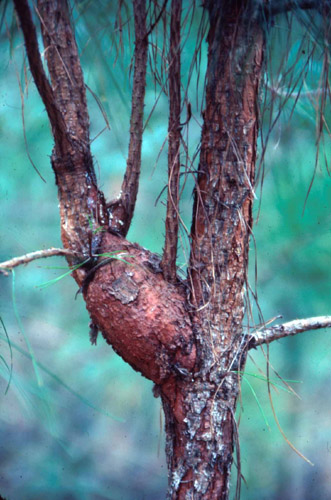Fusiform Rust
Natural History

Fusiform rust gall | Photo credit: G. Blakeslee - SFRC, Univ. of Florida
Fusiform rust is a disease caused by a fungus. This disease deforms or kills pine trees throughout the South, including north Florida. Since the late 1950s and early 1960s, fusiform rust has caused extensive damage in slash and loblolly pine plantations. The disease is estimated to cause many millions of dollars in losses in Florida each year.
The fungus requires two living host trees (pine and oak) to complete its life cycle. The fungus cannot spread directly from pine to pine. Young oak leaves are infected in the spring by wind-borne spores produced on pine trees. The fungus does minimal damage to the oak leaves, but later in the spring wind-borne spores produced on the young oak leaves infect new pine growth. The fungus can stunt, deform, or kill pine trees. In many cases, the fungus weakens the tree - causing branches to be easily broken off, or the whole tree to be blown over by wind.
Two common, interesting symptoms of fusiform rust are galls and witches brooms. Galls are abnormal growths and swellings that can be found on nearly every part of a plant. Galls can be caused by a variety of organisms including bacteria, fungi, nematodes, wasps, and mites. Fusiform rust often causes galls on the branches or main stem of pine trees.
A witch's broom occurs when a compact cluster of numerous twigs and branches shoots out from a common point - giving that section of the plant a broom-like appearance. Fusiform rust is just one of many factors that can create a witch's broom. This symptom can also result from various other sources, including certain insects and diseases.
